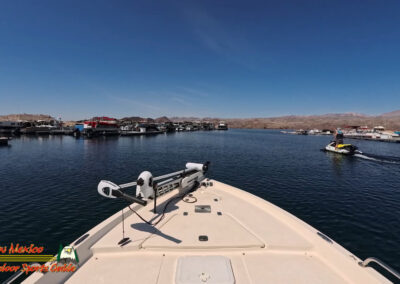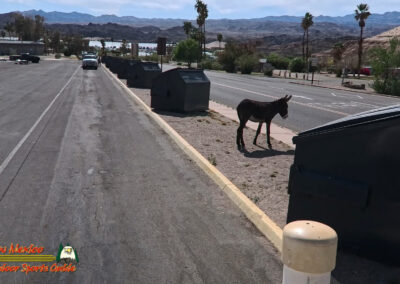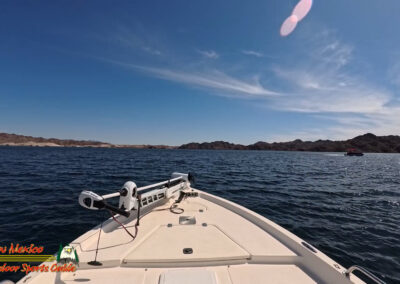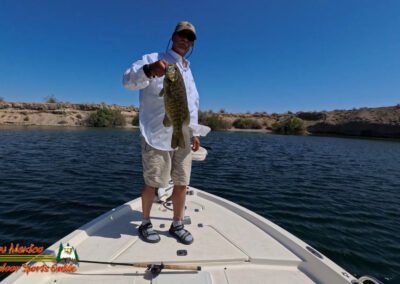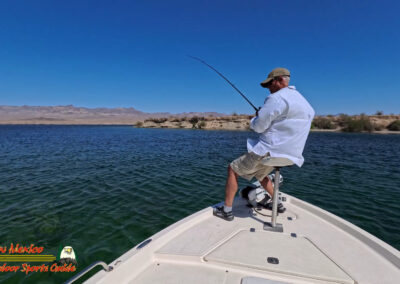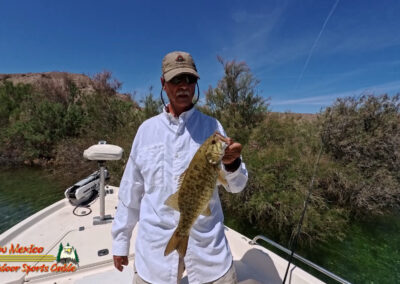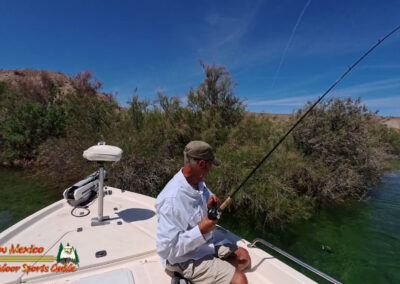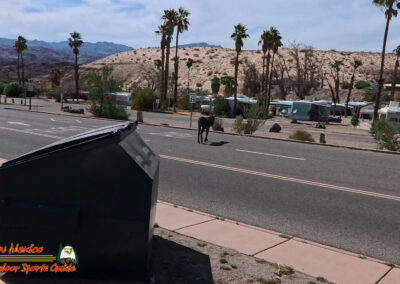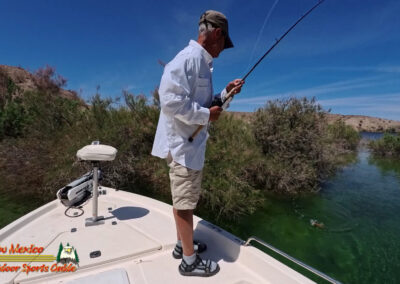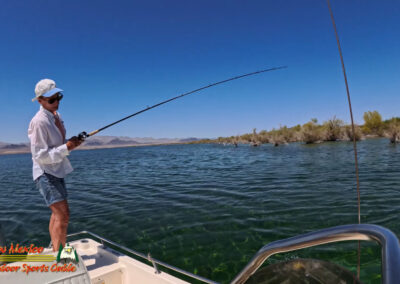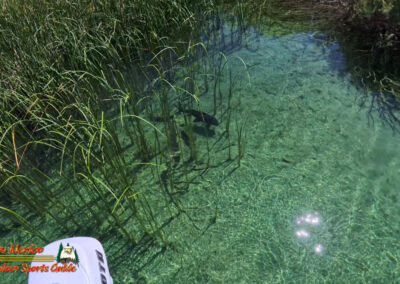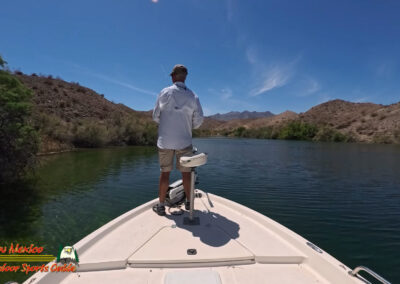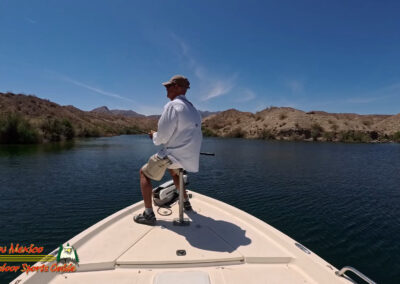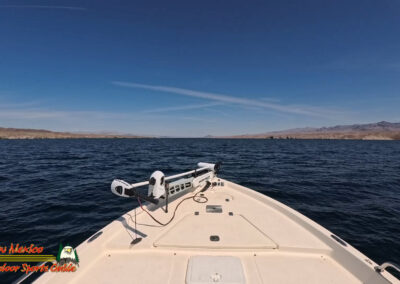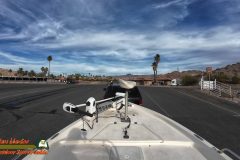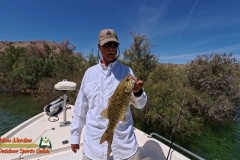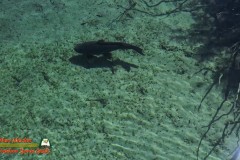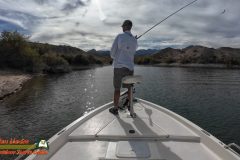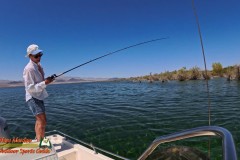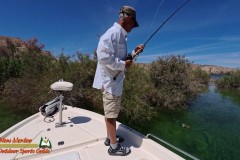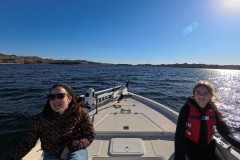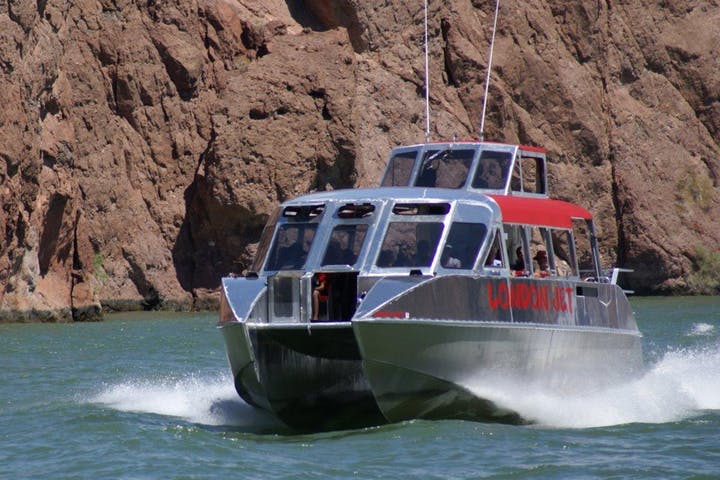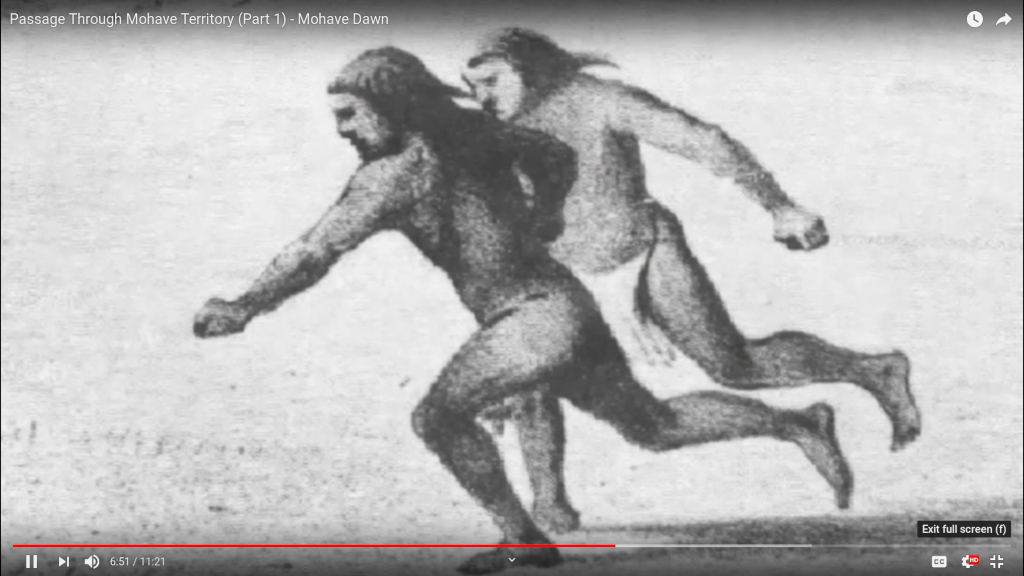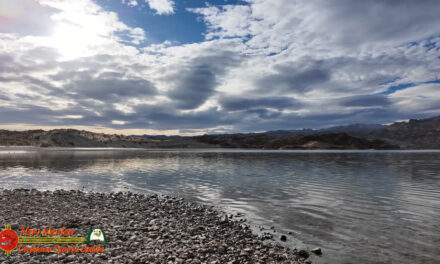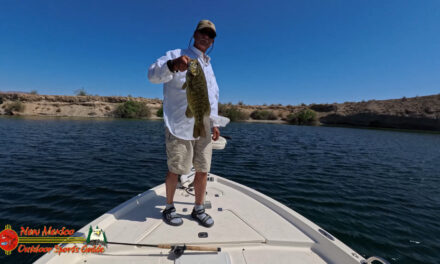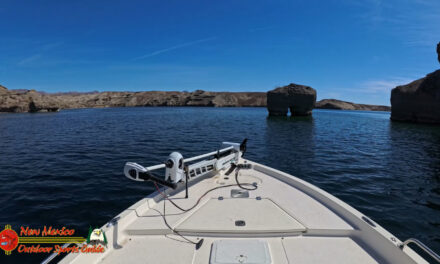The desert morning greeted us with that peculiar stillness that only those who’ve spent time in the Southwest truly understand. As I sipped my coffee on the porch of our modest desert retreat in the foothills above Lake Mohave, I watched the sun crawl above the horizon and paint the silhouette of Spirit Mountain red. Paulette was already bustling about, packing our cooler with the day’s provisions—her special beans and smoked sausage mixture that had sustained us through countless fishing adventures, alongside some fruit cocktail for dessert.
“Think they’ll be biting today?” she called from inside.
“Hard to say,” I replied, eyes still fixed on the mountain. “Water’s warming up, spawn’s about done. Could be good, could be slow.” Such is the philosophy of an old fisherman who’s seen enough seasons to know that nature offers no guarantees.
At eighty-some years, I’ve learned that fishing isn’t just about the catch. It’s about the quiet moments between casts, the way sunlight dances on water, and sharing it all with someone who understands the value of silence. Today would be no different—just Paulette and me, our 20-foot Key West center console, and the crystal clear waters of Lake Mohave stretching out before us like a promise.
A Life Between Mountains and Waters
Before I tell you about our day on Lake Mohave, you should know that water wasn’t always such a big part of my life. My boyhood unfolded across the windswept prairies of the Kansas Flint Hills, where tall grasses bent beneath the endless sky and cattle dotted the landscape like living punctuation marks. Ranch life taught me patience, respect for the land, and how to read nature’s subtle cues—skills that would serve me well decades later as an angler.
Now, in our golden years, Paulette and I have found our rhythm between two worlds. Summers find us in our log home perched high in Angel Fire, New Mexico, where our deck offers front-row seats to Wheeler Peak’s majesty, Bobcat Pass to the north, and Eagle Nest Lake shimmering in the valley below. But when winter’s grip tightens on those mountains, we migrate south to Arizona’s Lake Mohave, trading snowdrifts for saguaros and alpine winds for desert breezes.
This seasonal migration has become our dance with retirement—following fair weather and fish in equal measure. My camera and video equipment come along for the journey, capturing the wild heartbeat of the American Southwest through my octogenarian eyes.
Morning Launch at Katherine’s Landing
We took our time that April morning, no need to rush. That’s one of the privileges of age—you learn that haste rarely improves the outcome, especially when fishing is involved. By 10:00 AM, we had trailered our boat to Katherine’s Landing Marina, the sun already asserting its dominance in a cloudless sky.
“Going to be a scorcher,” observed the attendant at the launch, a leathery-faced man not much younger than myself.
“Nothing new under the desert sun,” I replied with a knowing smile.
Katherine’s Landing sits at the southern end of Lake Mohave, nestled within the Lake Mead National Recreation Area. The marina buzzed with the usual weekend warriors—families with coolers too large and sunscreen too sparse, young couples on rented jet skis, and serious anglers like ourselves, distinguished by well-worn gear and purposeful movements.
As I backed our trailer down the ramp, Paulette stood ready with the bow line, a choreography we’d perfected over forty plus years of marriage. Our Key West slipped into the water with barely a splash, its white hull gleaming against the deep blue of the lake. With practiced efficiency, we loaded our gear—two medium-action G. Loomis rods, our tackle boxes filled with an assortment of jigs and plastics, the essential cooler, and of course, my camera equipment safely stored in waterproof cases.
“Ready to find some Smallmouth?” I asked, settling behind the wheel.
Paulette secured her wide-brimmed hat and nodded. “Let’s see what they’re up to today.”
The Honda outboard roared to life, and we pulled away from the marina, heading north up the lake. Lake Mohave stretches nearly 67 miles from Davis Dam to Hoover Dam, a sapphire thread woven through the harsh desert landscape. Created in 1951 when Davis Dam impounded the Colorado River, it’s become a haven for anglers seeking Smallmouth Bass, Largemouth Bass, Striped Bass, and various panfish.
The Hunt Begins: Understanding Smallmouth Bass
As we cruised up the lake, I explained to my camera—setting up a segment for our outdoor video blog—the particulars of mid-April Smallmouth Bass fishing on Lake Mohave.
“Smallmouth Bass, or Micropterus dolomieu for you scientific types,” I narrated while Paulette navigated, “are in transition this time of year. Water temperatures in the mid-60s mean they’re just about finished spawning. Males are still guarding nests in some areas, but many are moving to post-spawn locations.”
I’ve always found Smallmouth fascinating creatures. Unlike their green cousins, the Largemouth Bass, Smallies prefer cooler, clearer water with rocky structure. Lake Mohave, with its clear Colorado River water and abundance of rocky coves, provides ideal habitat. The lake’s clarity, often exceeding 30 feet of visibility, makes it both a paradise and a challenge for anglers.
“Post-spawn Smallmouth can be finicky,” I continued for the camera, “They’re recovering from the energy-intensive spawning period and often move to slightly deeper water near their spawning grounds. Look for points, drop-offs, and submerged humps near spawning flats.”
After about a 15-mile run up the lake, we cut the engine and drifted into a promising cove on the Nevada side. Spirit Mountain loomed in the distance, its ancient presence a reminder of our temporal place in this timeless landscape. The Mojave people consider this mountain sacred, calling it Avikwame—the place where creation began. There’s something humbling about fishing in the shadow of creation stories.
First Cove Success: Paulette’s Prize
Paulette and I worked the rocky shoreline methodically, casting to likely holding spots where bass might be recuperating after their spawning efforts. She opted for a green pumpkin 3-inch tube jig, Texas-rigged to slip through the rocks without snagging. I chose a small brown crawfish imitation with orange highlights, hoping to trigger a reaction strike.
“There’s something about these desert reservoirs,” I mused, watching an osprey circle overhead. “The intersection of harsh desert and life-giving water creates a unique ecosystem.”
Paulette wasn’t listening. Her rod had suddenly bent double, line cutting sharply through the clear water.
“Got one!” she called, her voice carrying the same excitement I’d heard thousands of times before, yet never diminished by repetition.
I quickly set down my rod and grabbed the net with one hand and my camera with the other. After forty years together, I knew my priorities—document first, then assist.
The fish bulldogged deep, a telltale sign of a quality Smallmouth. Unlike Largemouth that often head for the surface to leap and throw the hook, Smallmouth typically dive deep, using their robust bodies and the water’s resistance to their advantage.
“It’s a good one,” Paulette said, her experienced hands keeping just enough pressure on the fish without giving it slack.
After a brief but spirited battle, a beautiful bronze torpedo appeared beneath the boat. I scooped it up, admiring its amber eyes and tiger-striped flanks.
“Three and a half pounds if it’s an ounce,” I declared, holding it up for the camera before Paulette carefully released it. “That’s a quality Smallie for Lake Mohave.”
The bass lingered momentarily at the surface, as if bidding farewell, then disappeared into the depths with a flick of its powerful tail.
“Still got it,” Paulette winked, rebaiting her tube jig.
The Rhythm of the Lake
We worked two more coves without success, though we marked several fish on the depth finder hovering near submerged structures. The day was warming rapidly, pushing toward the forecasted high of 95 degrees. By noon, we decided it was time for a break.
Finding a sheltered inlet with a small sandy beach, I eased the boat onto shore. We stepped out, stretching legs grown stiff from standing on the casting deck. This little cove, like so many on Lake Mohave, bore the unmistakable imprint of thousands of years of Colorado River geology—stratified rock layers telling ancient stories, desert varnish painting the cliffs in streaks of manganese oxide.
Growing up on that Kansas ranch, I’d sometimes find arrowheads or stone tools in freshly plowed fields, tangible links to those who worked the same land before me. Here in the desert Southwest, those connections feel even more immediate, preserved by the arid climate and stark landscape.
Paulette spread our simple feast on the front deck of the boat—her beans and smoked sausage mixture still chilled in the cooler, alongside crackers and the promised fruit cocktail. We ate slowly, savoring both the food and the pristine surroundings, occasionally pointing out a soaring raptor or interesting rock formation to each other.
“Remember when we used to pack fancy shore lunches?” she asked, scooping the last of her beans with a cracker.
“Bologna sandwiches and warm soda,” I laughed. “We’ve come up in the world.”
“The company’s still the same,” she replied, her hand finding mine across the deck. Even after four decades, such moments never lose their sweetness.
Afternoon Success and Desert Heat
Refreshed and refueled, we pushed back onto the lake, determined to find more Smallmouth before the day’s heat drove us off the water. The afternoon sun had transformed Lake Mohave into a mirror, reflecting the rugged desert mountains with such precision it was sometimes hard to discern where reality ended and reflection began.
We tried a new approach for the afternoon, switching to drop-shot rigs with small plastic worms in watermelon seed color. This technique keeps your bait suspended just above the bottom—ideal for less active fish or those holding deeper in the afternoon heat.
Three coves later, my persistence was rewarded with a solid thump on the line. Unlike Paulette’s fish, this one came to the surface immediately, dancing across the water in a series of spectacular jumps that sent spray flying.
“That’s why they call them ‘bronzebacks’!” I shouted, keeping the line tight between jumps. “Nothing fights like a Smallmouth!”
This fish was even larger than Paulette’s earlier catch, a thick-bodied specimen that would easily go over four pounds. As I brought it alongside the boat, Paulette was ready with the camera, returning the documentation favor.
“Beautiful fish, Pat,” she said as I hoisted it for a quick measurement and photo. “That’s your biggest of the season so far.”
The bass measured 19 inches with a girth that spoke of a healthy diet of crayfish and shad. After a few photos, I slipped it back into the clear water, watching as it quickly regained its equilibrium and disappeared.
“They’re such perfect creatures,” I said, more to myself than to Paulette. “Evolved over millions of years to be exactly what they need to be—no more, no less.”
When the Desert Reminds You Who’s Boss
By 3:00 PM, the wind had begun to assert itself, rippling the once-calm surface into small whitecaps. This wasn’t unusual for Lake Mohave, where afternoon winds often funnel through the river canyon with surprising force. Simultaneously, the heat had intensified, the mercury pushing toward that 95-degree mark with the relentless certainty of the desert.
“A taste of what’s coming,” I observed, wiping sweat from my brow. “Won’t be long before we’re looking at 115 and heading north to Santa Fe.”
Living seasonally between the high country and the desert gives you a keen appreciation for the extremes of both environments. The same lake that offers pleasant fishing in April becomes almost unbearable by June, when the Arizona sun transforms the landscape into a furnace. Similarly, our beloved mountain home in Santa Fe sits buried under several feet of snow as I write this—beautiful but impractical for octogenarians who’ve had their fill of shoveling snow.
“I’m feeling it,” Paulette admitted, seeking shade under her hat’s wide brim. “Might be time to call it a day.”
I nodded, knowing better than to push our luck with the desert heat. At our age, we’ve learned to respect our limitations while still embracing adventure. We’d caught some quality fish, captured excellent video footage for our blog, and enjoyed our time on the water—success by any measure.
Homeward Bound: Reflections on Water and Life
The ride back to Katherine’s Landing took us through the main channel of Lake Mohave, where the Colorado River’s influence is most apparent. The lake narrows here, with steep canyon walls rising on either side, creating a dramatic corridor of water and stone. I throttled back to take in the scenery, my photographer’s eye noting how the late afternoon light played on the stratified cliff faces.
“Want to get some B-roll?” Paulette asked, already reaching for my camera bag.
I smiled at how well she knows me. While I piloted the boat at a leisurely pace, she captured footage of the canyon walls, a pair of osprey circling overhead, and the wake of our boat as it spread across the azure water. These moments—the unexpected beauty found in transition times—often make the best segments for our outdoor videos.
The marina came into view all too soon, the white boats glinting in the afternoon sun like scattered diamonds. We fell into our practiced routine—Paulette at the wheel while she backed the trailer down the ramp, then the delicate dance of loading the boat, securing equipment, and checking that nothing was left behind.
As we drove the short distance back to our desert home, I found myself reflecting on the day. Two decent Smallmouth, hours of peaceful water time, and the companionship that has defined my life for four decades—not bad for a couple of transplanted flatlanders in their golden years.
Evening in the Desert: Tomorrow’s Promise
Back at our house in the foothills, with the boat rinsed and gear stowed, we settled onto the patio with tall glasses of iced tea. The view spread before us—Lake Mohave in the distance, Spirit Mountain turning purple in the setting sun, and the first stars appearing in the eastern sky.
“Good day,” Paulette said simply, raising her glass in a small toast.
“They’re all good days,” I replied, meaning it. At eighty-plus years, you develop a profound appreciation for each day granted, especially those spent doing what you love with who you love.
Tomorrow we’d sort through the footage, edit photos, and craft another entry for our outdoor blog that has, somewhat to my surprise, gathered a modest following among fishing enthusiasts and retirees seeking their own seasonal adventures. I’d write about the technical aspects of mid-April Smallmouth fishing—the transitions these fish undergo, the patterns they establish, the presentations that trigger strikes.
But more importantly, I’d try to capture this feeling—the contentment that comes from a life lived between mountains and waters, following seasons and fish with equal devotion. From Kansas ranch boy to mountain-dwelling angler, my journey has been shaped by landscapes and the simple wisdom they offer.
As darkness settled over the desert and the temperature finally began to relent, Paulette and I moved indoors, already discussing where we might try fishing tomorrow. Perhaps we’d venture farther up the lake toward Cottonwood Cove, or maybe explore some of the hidden inlets on the Arizona side. The possibilities stretched before us like the lake itself—finite yet seemingly endless, full of discovery for those willing to look beneath the surface.
Such is the blessing of our seasonal life—mountains and valleys, deserts and lakes, each offering its own treasures in its own time. And through it all, the fish wait, bronze torpedoes swimming through clear waters, connecting an old Kansas ranch boy to the ancient rhythms of this wild Southwest landscape.
About the Author spent his early years working his family’s cattle ranch in Kansas before pursuing a career in wildlife photography. Now retired and living in Santa Fe, New Mexico but wintering at Lake Mohave, Arizona he dedicates his time to documenting the wilderness and wildlife of the American Southwest, with a particular focus on the Mountains and Deserts of Arizona, Utah, Colorado and New Mexico. His work has been featured in New Mexico Outdoor Sports Guide blog and hundreds of NMOSG YouTube video publications.


